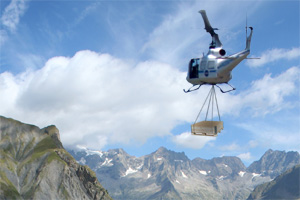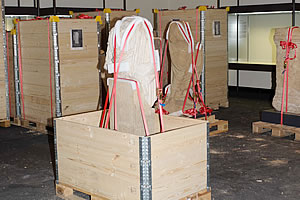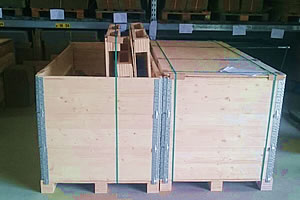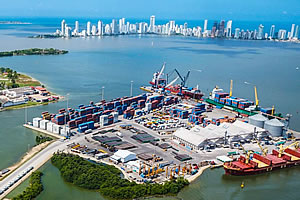- 03381 - 5463601
- kontakt@spreewald-verpackungen.de
- ANFRAGELISTE
Innovative and exciting customer solutions are being developed within our partner network. We would like to regularly publish some special examples here:

Customer: Supplier of alpine construction sites
Location: Austria
Objective: Safe and space-saving transport packaging for supplying alpine construction sites by helicopter
Initial situation: Our customer approached us with the unusual request to use the pallet stacking system for helicopter transport. The packaging needed to prevent the goods from falling. A secure border around a Euro pallet was required. At the same time, the packaging needed to be able to be stored and collected in a space-saving manner within a confined construction site area for later return transport.
Solution: Stacking frames with reinforced 2mm hinges were manufactured to Euro pallet dimensions. A precisely fitting, locked, and lightweight OSB lid completed the packaging. The stacking frames themselves were additionally secured to the pallet with a special latch. A steel frame made the stack easier to palletize and secure for return transport. After approximately 100 stacking frames had accumulated, the return transport for reuse could be accomplished in a single flight.

Client: State Archaeological Museum
Location: Southern Germany
Objective: Replacement of relatively expensive museum packaging. Compliance with packaging material emissions guidelines.
Initial situation: Through intensive consultations and the provision of information, we succeeded in establishing the collar system in the museum sector. Museum packaging is usually manufactured by specialized companies. The market is quite closed and therefore a costly proposition for customers. A courageous and innovative employee refused to accept this fact and considered interesting alternatives.
Solution: The pallets were designed as wooden frames for storing archaeological artifacts. OSB lids had to be of a low-evaporation quality. Special certifications allayed these concerns. Due to the unique value of the pieces, the use of stacking corners was recommended. Different sizes of pallets, pallets, and lids were also used.

Customer: Manufacturer of high-quality aluminum profiles
Location: Germany
Objective: Supply of small quantities of collars, pallets and lids in special sizes for the provision of packaging to a supplier in the USA
Initial situation: The customer previously used rigid and expensive crates for export to the USA. A local carpenter took over the production and delivery.
Solution: The pallet collars were over 2 meters long and wide. Therefore, the boards were placed individually and partially assembled in pre-assembled pallet collar crates with riveted hinges. The pallets and lids were also placed upright in the pallet collar crates. This method required only two pallet spaces and could be transported cost-effectively within Germany and also in a container to the USA.

Client: Industrial representation and representation of German companies
Location: Colombia, Bogota
Objective: Warehouse organization with over 30 different sizes and printing with different company logos. Partially assembled and space-saving delivery of pallets in sea containers
Initial situation: The bulky pallet cages were to be replaced with pallet collars. Due to the widely varying sizes of the products, storage in pallet cages was only partially possible.
Solution: Over 30 different sizes of pallet collars were manufactured, ranging from 400 mm to 1600 mm, along with matching lids and pallets. The pallet collars were personalized with the logos of our customer's customers. A total of six different company logos were printed on over 30 different pallet collars. The pallets were divided into upper and lower halves and stacked tightly. This enabled optimal use of the space in the shipping containers. A total of three to four containers leave the port for Colombia every year, and this has been the case for seven years now.